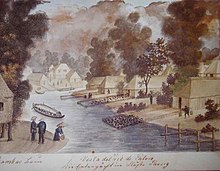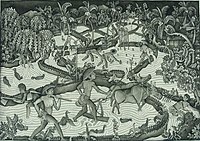Domestic duck
| Domestic mallard | |
|---|---|
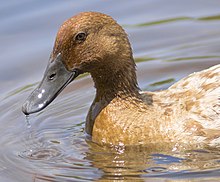
| |
| Khaki Campbellduck | |
Domesticated
| |
| Scientific classification | |
| Domain: | Eukaryota |
| Kingdom: | Animalia |
| Phylum: | Chordata |
| Class: | Aves |
| Order: | Anseriformes |
| Family: | Anatidae |
| Genus: | Anas |
| Species: | |
| Subspecies: | A. p. domesticus
|
| Trinomial name | |
| Anas platyrhynchos domesticus Linnaeus,1758
| |
| Domestic Muscovy | |
|---|---|
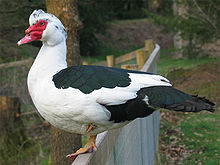
| |
| Domestic Muscovy | |
Domesticated
| |
| Scientific classification | |
| Domain: | Eukaryota |
| Kingdom: | Animalia |
| Phylum: | Chordata |
| Class: | Aves |
| Order: | Anseriformes |
| Family: | Anatidae |
| Genus: | Cairina |
| Species: | Fleming,1822
|
| Subspecies: | C. m. domestica
|
| Trinomial name | |
| Cairina moschata domestica (Linnaeus,1758)
| |
Domestic ducks(mainlymallard,Anas platyrhynchos domesticus,with someMuscovy ducks,Cairina moschata domestica) are ducks that have beendomesticatedand raised formeatandeggs.A few are kept for show, or for their ornamental value. Most varieties of domesticated ducks, apart from the Muscovy duck and hybrids, are descended from the mallard, which was domesticated in China around 2000 BC.
Duck farming is simplified by their reliableflockingbehaviour, and their ability toforageeffectively for themselves. Over 80% of global duck production is in China. Breeds such asWhite Pekinare raised for meat, while the prolificIndian Runnercan produce over 300 eggs per year. In East and Southeast Asia,polyculturessuch asrice-duck farmingare widely practised: the ducks assist thericewith manure and by eating smallpestanimals, so that the same land produces rice and ducks at once.
In culture, ducks feature in children's stories such asThe Tale of Jemima Puddle-Duck,and inSergei Prokofiev's musical compositionPeter and the Wolf;they have appeared in art since the time ofancient Egypt,where they served as afertility symbol.
Origins
[edit]Domestication
[edit]Domestic ducks appear fromwhole-genome sequencingto have originated from a single domestication event ofmallardsduring theNeolithic,followed by rapid selection for lineages favouring meat or egg production. They were probably domesticated inSouthern Chinaaround 2000 BC[1][2]– by therice paddy-farming ancestors of modern Southeast Asians – and spread outwards from that region. There are few archaeological records, so the date of domestication is unknown; the earliest written records are inHan Chinesewritings fromcentral Chinadating to about 500 BC. Duck farming for both meat and eggs is a widespread and ancient industry in Southeast Asia.[1]
Wild ducks were hunted extensively inEgyptand other parts of the world in ancient times, but were not domesticated. Ducks are documented inAncient Romefrom the second century BC, but descriptions – such as byColumella– suggest that ducks in Roman agriculture were captured in the wild, not domesticated; there was no duck breeding in Roman times, so eggs from wild ducks were needed to start duck farms.[3]
Origins of breeds
[edit]Mostbreedsand varieties of domestic duck derive from themallard,Anas platyrhynchos;a few derive fromCairina moschata,the Muscovy duck, or aremulards,hybrids of these withA. platyrhynchosstock.[2]Domestication has greatly altered their characteristics. Domestic ducks are mostlypromiscuous,where wild mallards aremonogamous.Domestic ducks have lost the mallard's territorial behaviour, and are less aggressive than mallards.[4][5]Despite these differences, domestic ducks frequently mate with wild mallard, producing fully fertilehybridoffspring.[6]A wild mallard weighs some 1.1 kg (2.4 lb), but large breeds like theAylesburymay weigh 4.6 kg (10 lb) (and hybrids even more), while small breeds like the Appleyard may be only 0.7 kg (1.5 lb). Those breeds are raised for meat and eggs,[2]while other breeds are purely ornamental, having been selected for their crests, tufts, or striking plumage, for exhibition in competitions.[7]
Aphylogenomicanalysis found that Indian breeds of ducks formed a cluster that was sister to theWhite Pekinduck (a breed derived from ducks domesticated in China), while Muscovy ducks are from another genus.[8]
|
-
White Pekinsare raised for meat.
-
Muscovy ducksproduce a richly-flavoured meat, and are kept as pets.
Farming
[edit]Husbandry
[edit]Ducks have been farmed for thousands of years.[10]They are reared principally for meat, but also forduck eggs.[11]: 258 Duck husbandry is simplified by aspects of their behaviour, including reliable flocking and the ability to forage effectively for themselves in wetlands and water bodies.[10]
Most breeds of duck may lay some 200 eggs per year,[11]: 258 though theIndian Runnermay produce over 300 eggs annually.[2]The females of many breeds of domestic duck areunreliable at sitting their eggsand raising their young. Exceptions include theRouen duckand especially theMuscovy duck.It has been a custom on farms for centuries to put duck eggs underbroody hensfor hatching; nowadays this role is often played by anincubator.However, young ducklings rely on their mothers for a supply ofpreen oilto make them waterproof; a chicken does not make as much preen oil as a duck, and an incubator makes none. Once the duckling grows its own feathers, it produces preen oil from the sebaceous gland near the base of its tail.[12]
-
Painting byJosé Honorato Lozanoof duck farms along thePasig Riverin the Philippines, 1821
-
Turning duck eggs in front of incubators, Germany, 1952
-
Duck farm in the Philippines, 2014
-
Inspecting duck eggs at a hatchery, Vietnam, 2014
Systems
[edit]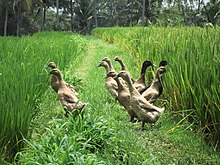
In East and Southeast Asia,rice-duck farmingis widely practised. Thispolycultureyields both rice and ducks from the same land; the ducks eat smallpestanimals in the crop; they stir the water, limiting weeds, and manure the rice. Otherrice polyculturesin the region include rice-fish-duck and rice-fish-duck-azollasystems, where fish further manure the rice and help to control pests.[13][14]
Pests and diseases
[edit]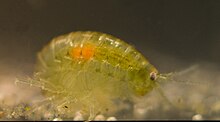
Domestic ducks have the advantage over otherpoultryof being strongly resistant to many bird diseases, including such serious conditions asduck plague(viral enteritis).[10]They are however susceptible to the dangerousH5N1strain ofavian influenza.[15]Ducks are subject toectoparasitessuch asliceandendoparasitessuch astrematodes,cestodes,[16]andacanthocephalans.A high parasitic load can result in a substantial reduction in the ducks' growth rate.[17]
Production
[edit]In 2021 approximately 4.3 billion ducks were slaughtered for meat worldwide, for a total yield of about 6.2 million tonnes;[18]over 80% of this production was in China, where more than 3.6 billion ducks were killed, yielding some 4.9 million tonnes of meat.[19]Worldwide production of duck meat was substantially lower than that ofchicken– 73.8 billion birds slaughtered, 121.6 million tonnes – but considerably greater than that ofgoose– about 750 million birds killed for 4.4 million tonnes of meat.[18]Feathers are a by-product of duck farming.[20]
As food
[edit]Meat
[edit]Since ancient times, the duck has been eaten as food.[21]Usually only the breast and thigh meat is eaten.[22]It does not need to behungbefore preparation, and is often braised or roasted, sometimes flavoured withbitter orangeor withport.[23]Peking duckis a dish of roast duck fromBeijing,China, that has been prepared since medieval times. It is today traditionally served withspring pancakes,spring onionsandsweet bean sauce.[24][25]
Eggs and other products
[edit]In France, ducks are used for the production offoie gras de canard.[11]: 311 In some cultures thebloodof ducks slaughtered for meat is used as food; it may be eaten seasoned and lightly cooked, as in Ireland,[26]: 392 or be used as an ingredient, as in a number of regional types ofblood soup,among them theczarninaof Poland[27]: 299 and thetiết canhof Vietnam.[20]
Duck eggs are eaten mainly in Asian countries such as China;[11]: 258 in the Philippines,balut– a fertilised duck egg at about 17 days of development, boiled and eaten with salt – is considered a delicacy and is sold asstreet food.[11]: 53
-
Duck eggs (left), larger and greener than chicken eggs (right) at market, Hong Kong, 2022
-
Sichuan-style tea-smokedzhangcha duck
-
Duckliver pâté
In culture
[edit]For children
[edit]
The domestic duck has appeared numerous times in children's stories.Beatrix Potter'sThe Tale of Jemima Puddle-Duckwas published byFrederick Warne & Coin 1908. One of Potter's best-known books, the tale was included in theRoyal Ballet'sThe Tales of Beatrix Potter.[28]It is the story of how Jemima, a domestic duck, is saved from a cunning fox who plans to kill her, when she tries to find a safe place for her eggs to hatch.[29] The Story About Pingis a 1933 American children's book byMarjorie Flack,illustrated byKurt Wiese,about a domestic duck lost on theYangtze River.[30] Make Way for Ducklings,a 1941 children's picture book by Robert McCloskey, tells the story of a pair of mallards who decide to raise their family on an island in the lagoon in Boston Public Garden. It won the 1942Caldecott Medalfor its illustrations.[31]TheDisneycartoon characterDonald Duck,one of the world's most recognizable pop culture icons, is a domestic duck of theAmerican Pekinbreed.[32]
The domestic duck features in the musical compositionPeter and the Wolf,written by the Russian composerSergei Prokofievin 1936.[33]The orchestra illustrates thechildren's storywhile the narrator tells it.[34]In this, a domestic duck and a little bird argue on each other's flight capabilities. The duck is represented by theoboe.The story ends with the wolf eating the duck alive, its quack heard from inside the wolf's belly.[35]
| The duck theme inPeter and the Wolf:Oboe |
|---|
![\relative c' { \clef treble \time 3/4 \set Staff.midiInstrument = #"oboe" \tempo "L'istesso tempo"4=92 \key aes \major \slashedGrace fes8( ees2.\mf->) | \slashedGrace ees8( d[ des c des] \slashedGrace d g[ f)] | \slashedGrace fes( ees2.->) }](https://upload.wikimedia.org/score/p/z/pzz89ag8b6itbx13c4u2oj06fmhw6ke/pzz89ag8.png) |
In art and folk culture
[edit]Domestic ducks are featured in a range of ancientartefacts,which revealed that they were a fertility symbol.[36]
-
Pendantwith duck's head,
England, c. 650 AD -
Edvard Munch's paintingJensen with Slaughtered Duck,1912
-
Balinese traditional paintingdepictingpaddy fields with ducksforaging for food, 1940
-
'The Big Duck', Long Island, New York: built on a duck farm, 1931
References
[edit]- ^abZhang, Zebin; Jia, Yaxiong; Almeida, Pedro;Mank, Judith E;van Tuinen, Marcel; Wang, Qiong; et al. (1 April 2018)."Whole-genome resequencing reveals signatures of selection and timing of duck domestication".GigaScience.7(4).doi:10.1093/gigascience/giy027.PMC6007426.PMID29635409.
- ^abcdeAppleby, Michael C.; Mench, Joy A.; Hughes, Barry O. (2004).Poultry Behaviour and Welfare.Centre for Agriculture and Bioscience International.p. 9.ISBN978-0-851-99667-7.
- ^Albarella, Umberto (2005). "Alternate fortunes? The role of domestic ducks and geese from Roman to Medieval times in Britain". In G., Grupe; J., Peters (eds.).Feathers, Grit and Symbolism: Birds and Humans in the Ancient Old and New Worlds(PDF).Documenta Archaeobiologiae III. Verlag Marie Leidorf. pp. 249–258.ISBN9783896466181.
- ^Piggott, Stuart; Thirsk, Joan (February 1981).The Agrarian History of England and Wales: Volume 1, Part 1, Prehistory.Cambridge University Press.ISBN978-0-521-08741-4.
- ^DigiMorph Staff (2004)."Anas platyrhynchos, Domestic Duck".University of Texas at Austin.Archived fromthe originalon 27 November 2016.Retrieved23 December2012.
- ^Wood-Gush, D. (2012).Elements of Ethology: A textbook for agricultural and veterinary students.Springer.p. PT212.ISBN978-9-400-95931-6.
- ^"The best ducks to keep in your garden: in pictures".The Daily Telegraph.Retrieved28 June2017.
- ^abVeeramani, P.; Prabakaran, R.; Sivaselvam, S. N.; Sivakumar, T.; Selvan, S. T.; Karthickeyan, S. M. K. (1 March 2016)."Phylogenetic analysis of six duck populations"(PDF).Indian Journal of Animal Research.50(4): 626–628.doi:10.18805/ijar.9301.ISSN0976-0555.
- ^"Indian Runner Duck: Anas platyrhynchos domesticus".Zoo Berlin.Retrieved7 May2024.
- ^abcChurchil, R. Richard; Jalaludeen, A. (2022). "Duck Farming: Opportunities, Constraints and Policy Recommendations".Duck Production and Management Strategies.Singapore: Springer Nature Singapore. pp. 617–657.doi:10.1007/978-981-16-6100-6_16.ISBN978-981-16-6099-3.
- ^abcdeDavidson, Alan(1999). "Duck".The Oxford Companion to Food.Oxford:Oxford University Press.ISBN9780192115799.
- ^"Ducks".Poultry Breeds Encyclopedia.
- ^abBezemer, Marjolein (23 October 2022)."Mixed farming increases rice yield".reNature Foundation.Archivedfrom the original on 11 October 2019.Retrieved2 January2024.
- ^Furuno, Takao (2009).Traditional and modern matters on rice cultivation associated with duck.6th International Rice–Duck Conference. Cebu, The Philippines. pp. 23–27.
- ^Songserm, Thaweesak; Jam-on, Rungroj; Sae-Heng, Numdee; Meemak, Noppadol; Hulse-Post, Diane J.; Sturm-Ramirez, Katharine M.; Webster, Robert G. (April 2006)."Domestic Ducks and H5N1 Influenza Epidemic, Thailand".Emerging Infectious Diseases.12(4): 575–581.doi:10.3201/eid1204.051614.ISSN1080-6040.PMC3294714.PMID16704804.
- ^Musa, Sharmin; Rahman, Tania; Khanum, Hamida (2012)."Prevalence and intensity of parasites in domestic ducks".Dhaka University Journal of Biological Sciences.21(2): 197–199.doi:10.3329/dujbs.v21i2.11518.
- ^Anisuzzaman; Alim, M. A.; Rahman, M. H.; Mondal, M. M. H.; Anisuzzaman; Alim, M. A.; et al. (2005). "Helminth parasites in indigenous ducks: Seasonal dynamics and effects on production performance".Journal of the Bangladesh Agricultural University.doi:10.22004/AG.ECON.276489.
- ^abProduction Crops Livestock E All Area Groups NOFLAG(large download). Rome:Food and Agriculture Organization.Accessed June 2023. Lines 323–330.
- ^Production Crops Livestock E All Data NOFLAG(large download). Rome:Food and Agriculture Organization.Accessed June 2023. Lines 10405–10406.
- ^abDuck and Goose from Farm to Table.Washington, DC: Food Safety and Inspection Service of theUnited States Department of Agriculture.Archived 20 September 2013.
- ^Dalby, Andrew(2013).Food in the Ancient World from A to Z.Routledge.p. 124.ISBN978-1-135-95422-2.
- ^"Duck".The Visual Food Encyclopedia.Québec Amerique. 1996. p. 584.ISBN978-2-764-40898-8.
- ^Davidson, Alan(2006).The Oxford Companion to Food.Oxford University Press.p. 472.ISBN978-0-191-01825-1.
- ^"The Evolution of Peking Duck".CBS.24 September 2006. Archived fromthe originalon 3 May 2008.
- ^"A Cultural Classic: Peking Duck".Globe Trekker.Archived fromthe originalon 17 May 2012.Retrieved26 June2017.
- ^Allen, Darina (2018).Irish Traditional Cooking.London:Kyle Books.ISBN9780857836960.
- ^McLagan, Jennifer (2017).Blood, Not So Simple.In: McWilliams, Mark (ed.) (2017).Offal: Rejected and Reclaimed Food: Proceedings of the 2016 Oxford Symposium on Food and Cookery.London:Prospect Books.ISBN9781909248557.
- ^Roberts, Laura (16 December 2010)."The Tales of Beatrix Potter performed by The Royal Ballet".The Daily Telegraph.Archived fromthe originalon 21 August 2016.Retrieved26 June2017.
- ^Potter, Beatrix(1993).The Tale of Jemima Puddle-Duck.Frederick Warne.ISBN9781854713858.
- ^Marjorie Flack; Kurt Wiese (1933).The Story About Ping.Viking Press.ISBN978-0-670-67223-3.
- ^"Randolph Caldecott Medal".American Library Association.2021.Retrieved27 June2023.
- ^"Pekin Ducks".Oklahoma State University Extension – Department of Food & Animal Sciences.20 July 2021.Retrieved27 June2023.
- ^Nicholas, Jeremy (25 May 2021)."Prokofiev's Peter and the Wolf | A Complete Guide To The Best Recordings".Gramophone.Archivedfrom the original on 3 August 2021.Retrieved2 July2024.
Peter is a Soviet boy who takes care of his pet animals, including a bird, a duck, and a cat. When a wolf invades his domestic zoo, Peter organises a hunt, rounds up the predator and takes him to the zoo.
- ^De Rijke, Victoria (2008).Duck.Reaktion Books.p. PT24.ISBN978-1-861-89489-2.
- ^Prokofiev, Sergei(1999).Peter and the Wolf.North-South Books. pp. 1–28.ISBN978-0-735-81189-8.
- ^Chadd, Rachel Warren; Taylor, Marianne (2016). "Anatidae: Duck".Birds: Myth, Lore and Legend.Bloomsbury Publishing.pp. 12–15.ISBN978-1-472-92287-8.
External links
[edit]![]() Media related toBreeds of domesticated Anas platyrhynchosat Wikimedia Commons
Media related toBreeds of domesticated Anas platyrhynchosat Wikimedia Commons
![]() Duckat the Wikibooks Cookbook subproject
Duckat the Wikibooks Cookbook subproject



![Indian Runner ducks stand upright, do not fly, and may produce over 300 eggs per year.[2][9]](https://upload.wikimedia.org/wikipedia/commons/thumb/0/09/Runner-ducks.jpg/180px-Runner-ducks.jpg)
